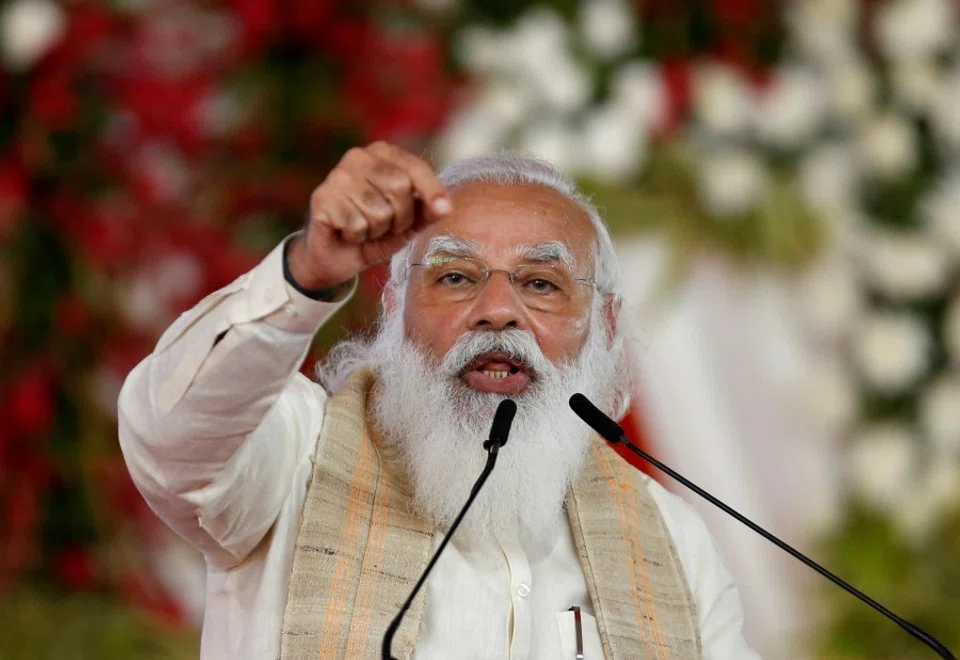Quad now centrepiece in India's China strategy
In the past, India was reticent about participating in the Quad. But amid China's growing military, economic and diplomatic assertiveness and India's decreasing capability to balance China on its own, the prospect of a Quad mechanism to help it do so is looking more attractive. At the recent first Quad summit, leaders committed to expanding vaccine production in India and building resilient supply chains. If all stars align, India is set to play a greater role in the Quad. How will it use this to its advantage in Sino-Indian relations? Yogesh Joshi analyses the issue.

A couple of days before the summit meeting of the Quadrilateral Security Dialogue or the Quad in March 2021, Chinese Foreign Minister Wang Yi argued that India and China should refrain from implementing policies aimed at "undercutting each other". Wang Yi was cautioning India against a tighter embrace of the Quad, a coalition of the willing among Indo-Pacific's four major maritime democracies - India, Japan, Australia and the US.
In Beijing, the Quad naturally evokes both fear and anxiety. The Quad not only brings together the most powerful military actors in the Indo-Pacific, it also presents an ideological challenge to the Chinese state. The Quad is also the edifice of a possible balance of power against China's growing assertiveness in the region, which may not only challenge China's rise but may well stifle it altogether. Therefore, if the Quad's success is dependent upon its cohesiveness, China's rise is contingent on its implosion.
India erstwhile considered weakest link in Quad
Beijing's warnings were not without substance as it enjoys significant leverage over India. For one, the military disengagement process in the eastern Himalayas which began in February 2021 after almost a year of eyeball-to-eyeball military deployments is still incomplete, with several strategic locations still under the PLA's military control. The tactical situation on the ground should have forced India to reconsider its approach towards the Quad. Second, among all Quad countries, India is the only country sharing a border with China and faces an existential threat on its borders. The growing gap in military and economic power between New Delhi and Beijing only heightens India's strategic vulnerability. Beijing can build up the military pressure on New Delhi whenever it so intends; the un-demarcated Himalayan frontier provides her with a genuine reason to ratchet hostilities at will.

Furthermore, unlike Japan and Australia, India is not a treaty ally of the US. Even when Indo-American strategic partnership has grown tremendously in the last decade or so, no American soldier is duty-bound to fight for India's territorial integrity vis-à-vis China. Lastly, there still exists significant opposition in India's domestic politics against New Delhi's strategic alignment with the US and other Quad countries. New Delhi's embrace of the Quad, many argue, reduces India's strategic autonomy, deviates from its traditional non-aligned foreign policy, and unnecessarily entraps India into the Sino-US conflict. Not without reason, therefore, India is often considered as the weakest link in the Quad.
India's earlier reticence on the Quad
India's structural weaknesses and its fractured domestic politics were primarily responsible for its hurried exit from the Quad in its earlier avatar. It was during his speech at India's parliament in August 2007 that Japan's Prime Minister Shinzo Abe first exhorted the four maritime democracies to rally around the idea of Quad, a collective security hedge against China's rise in the region. Later that year, India hosted the first-ever joint naval exercise between the Quad countries in the Bay of Bengal. However, New Delhi's enthusiasm withered under Beijing's strong diplomatic protestations, who saw the Quad as deliberately provocative. For one, India believed that mutual accommodation may eventually help reach a justifiable settlement with China. New Delhi, therefore, focused its energies on confidence-building measures (CBMs) at the border and greater interdependence in the economic realm.

Second, Chinese decision-makers were still singing the song of its peaceful rise; its military, economic and diplomatic assertiveness was yet to be unleashed. Therefore, the view that Quad may engender a security dilemma in the Indo-Pacific was not without merit. Lastly, if China was rising, so was India. India felt confident that it would be able to take on Beijing on its own. The military and economic gap between the two Asian countries was relatively small. Under these circumstances, the Indian government felt more comfortable in treading on the path of strategic autonomy and non-alignment.
The only recourse left for New Delhi is to balance China through external help.
Quad's stock rises in India's eyes
The situation has changed dramatically in the last decade. If the 2008 global financial crisis catapulted China as the world's imminent great power, the arrival of Xi Jinping unleashed its military and diplomatic assertiveness across the Indo-Pacific. For New Delhi, China's behaviour has become particularly hostile, with the two Himalayan countries engaging in several intense military crises on the border. The assumption that greater economic cooperation and trust-building through CBMs would help resolve Sino-Indian differences has come a cropper.
Second, whereas China has maintained its economic growth, New Delhi's rise has been clouded by its modest economic performance. India's incapability to balance China on its own is evident not only in the growing military disparity on the land frontier but also in the growing profile of the Chinese Navy in the Indian Ocean. On the other hand, Beijing's economic diplomacy in South Asia has challenged India's primacy in the region; the Belt and Road initiative has shifted South Asia's balance of economic and diplomatic power in China's favour. For the first time in India's history, it is facing a hostile great power in its immediate neighbourhood. The clash of fundamental interests - the border dispute and primacy in South Asia - does not allow India to reach an accommodation with Beijing. The only recourse left for New Delhi is to balance China through external help.
A resolve to challenge China's rise
The Quad has, therefore, gained tremendous traction in India's foreign policy. First cooperating with the Quad countries allows New Delhi to plug significant gaps in its internal capabilities to balance China. If India's economic cooperation with Quad countries smoothens the process of economic decoupling with China, technology collaboration, specifically in emerging areas such as 5G, ensures that India remains invulnerable to technological coercion from Beijing. More importantly, India aims to maintain a qualitative edge over Beijing's otherwise enormous military capabilities. India's participation in the Quad ensures a liberal flow of top-end military equipment from the US and other developed democracies. Diplomatically too, the Quad provides India with significant leverage in South Asia and the Indian Ocean.
It is to New Delhi's credit that the Quad's agenda has expanded from narrow security cooperation to challenging Beijing's monopoly on development aid, connectivity, and infrastructure projects in the region. India is collaborating with Japan for infrastructure development in Bangladesh, Myanmar, and Sri Lanka. New Delhi, Tokyo, and Canberra have also joined hands to reduce their dependence on Chinese supply chains. The decision to provide 1 billion Covid-19 vaccines to countries in the Indo-Pacific is a signal that the Quad is willing to contest China's economic and diplomatic influence in the region.
Long a sideshow, the Quad has now become central to Sino-Indian competition in the Indo-Pacific.

More importantly, however, India's embrace of the Quad signals a resolve to challenge China's rise in the region. This resolve is a result of China's assertiveness but also the change in the attitude within India. New Delhi may have advocated the desire for a multipolar world order in the past but is currently fixated on the need to avoid China's hegemony in Asia. India's interests as well as its quest for status do not allow it to accommodate China as a great power and vice versa. In the face of a rising and assertive China, India's options are extremely limited. Its need for external partners has never been so pressing. As India's former ambassador to Beijing Vijay Gokhale argued during the height of the Galwan military crisis, "The world needs balance - at the moment, no country other than the United States has the means to ensure it."
Yet, the role of the incumbent Modi government in New Delhi is not insignificant. Unburdened from the baggage of traditional foreign policy tropes such as strategic autonomy and non-alignment, Modi has induced greater pragmatism in India's dealing with the world. It is not without reason that it was under the Modi government that New Delhi signed three of the four major foundational defence agreements with the US. It is also to Modi's credit that unfazed by China's pressure on the border, New Delhi invited Australia to the Malabar series of naval exercises last year. Modi's message to China is simple: no amount of pressure will work if India believes that Quad works in her interests.
Long a sideshow, the Quad has now become central to Sino-Indian competition in the Indo-Pacific.



![[Photos] Fact versus fiction: The portrayal of WWII anti-Japanese martyrs in Taiwan](https://cassette.sphdigital.com.sg/image/thinkchina/3494f8bd481870f7c65b881fd21a3fd733f573f23232376e39c532a2c7593cbc)

